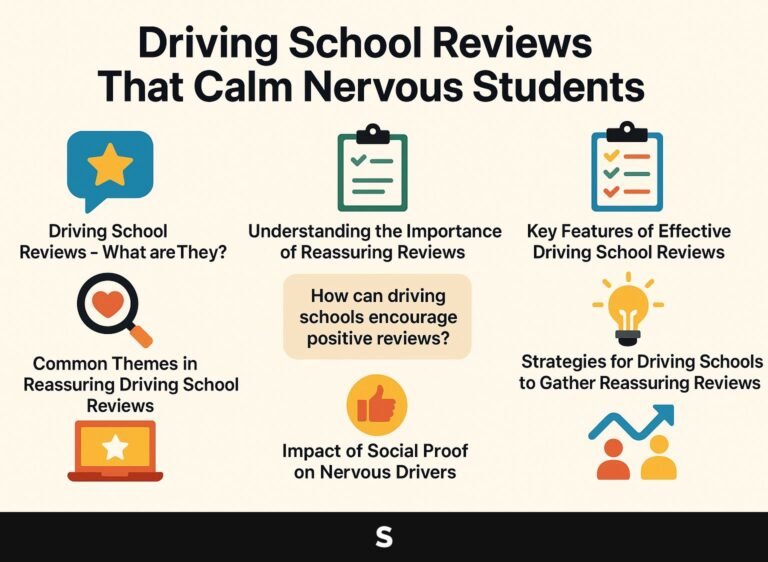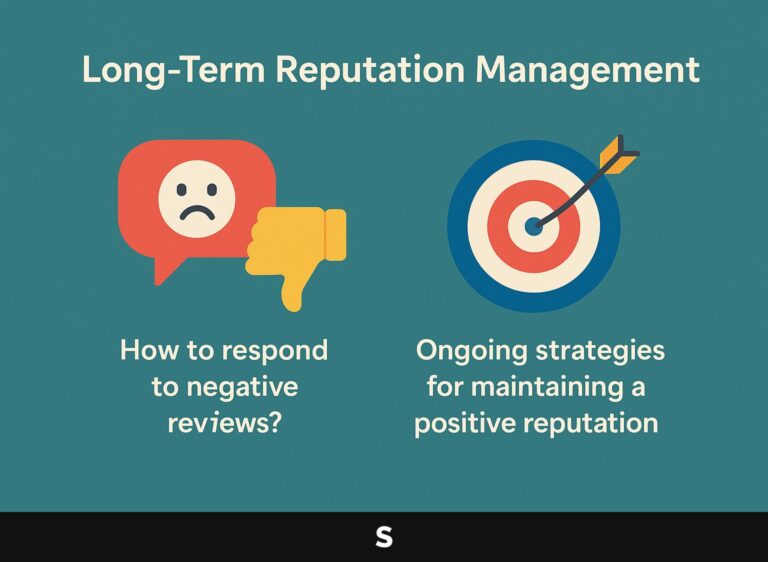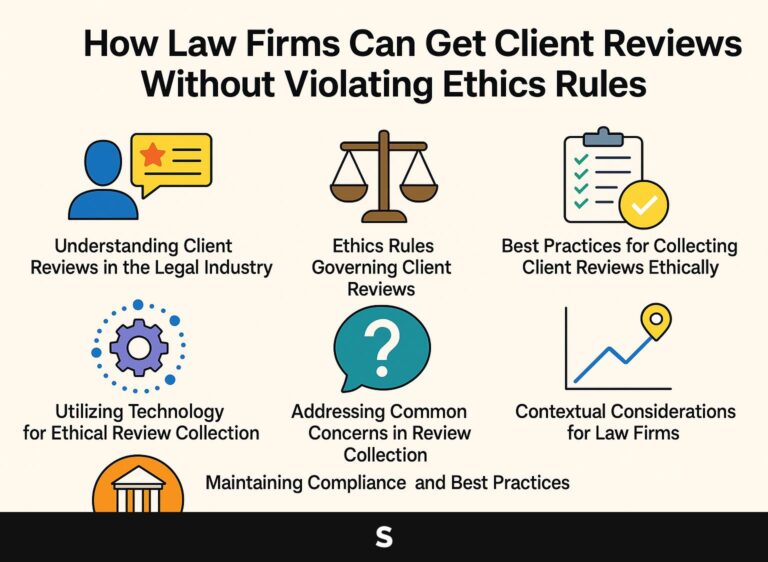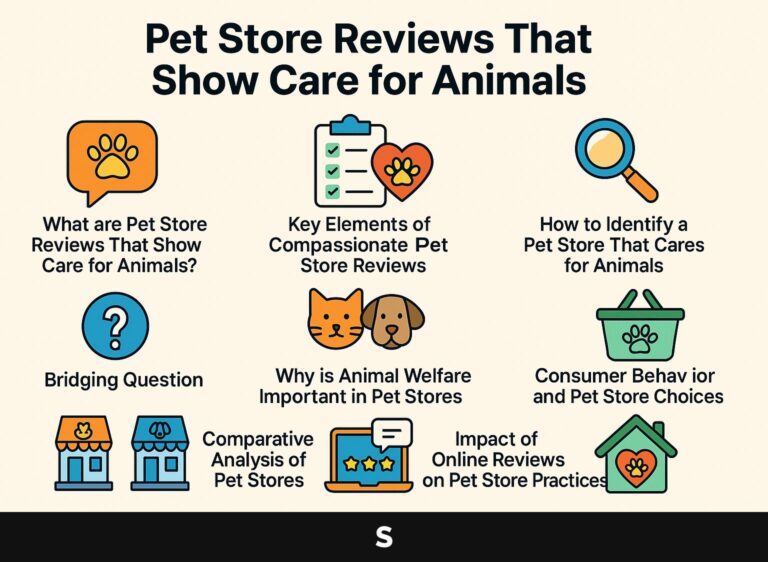Dermatology Clinic Reviews That Build Patient Confidence
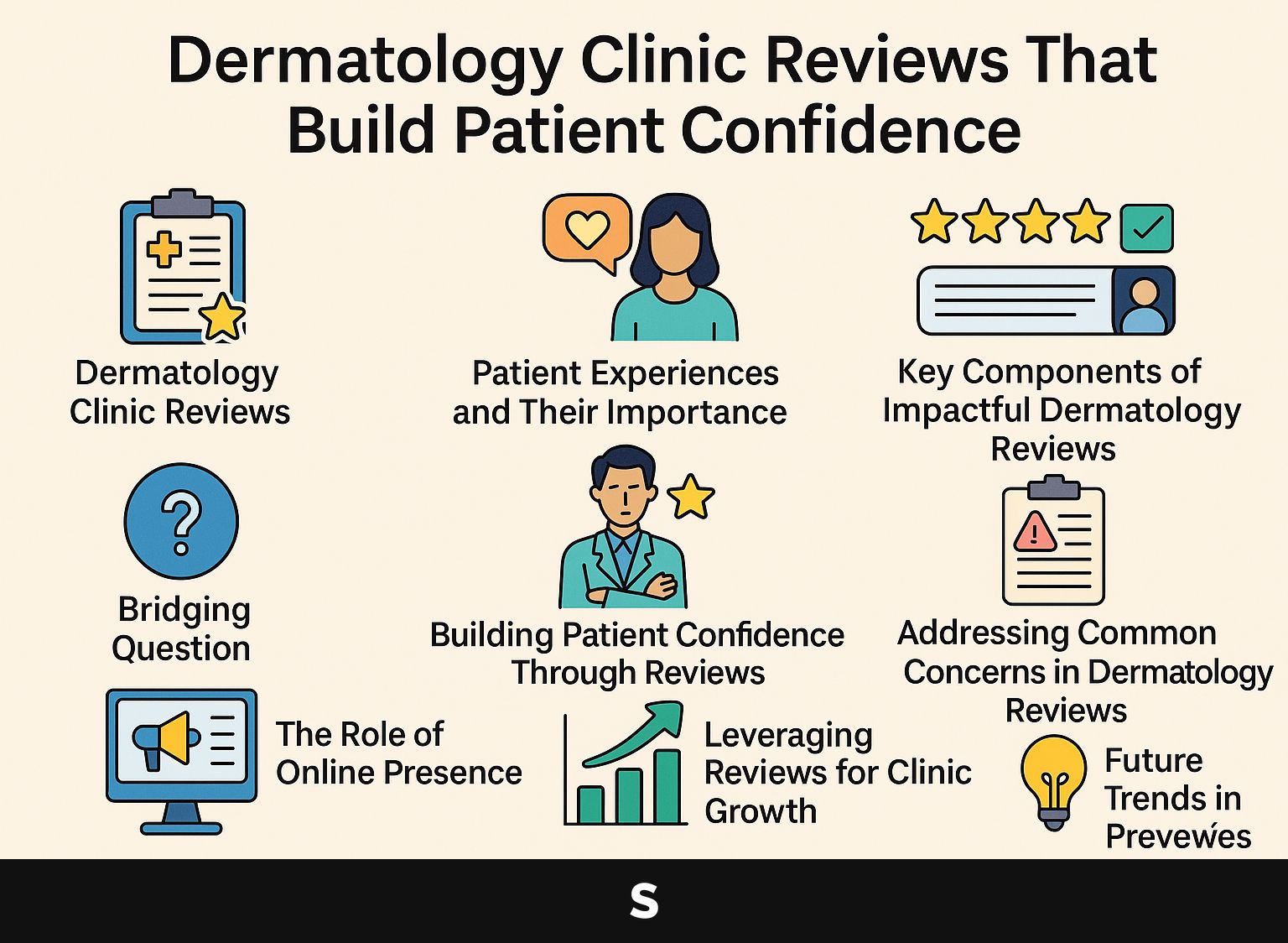
In the quest for clear skin, patient experiences can be a powerful guide. Reviews from dermatology clinics, such as Brigham and Women’s Hospital, highlight treatment outcomes and patient satisfaction. Using platforms like Patient Gateway and MyChart makes healthcare more open, letting you read real experiences from people with similar situations.
This article explains how these reviews can increase your confidence and guide you through the field of dermatology successfully.
Key Takeaways:
- Positive dermatology clinic reviews build patient confidence and trust.
- Personal stories and visible treatment results play a key role in impactful reviews.
- Online reputation and effective use of reviews can lead to clinic growth and improved services.
- Dermatology Clinic Reviews – What are they?
- Patient Experiences and Their Importance
- Key Components of Impactful Dermatology Reviews
- How can clinics encourage patients to leave positive reviews?
- Building Patient Confidence Through Reviews
- Addressing Common Concerns in Dermatology Reviews
- Online Activity: The Importance of Being Visible Online
- Leveraging Reviews for Clinic Growth
- Future Trends in Dermatology Reviews
- Frequently Asked Questions
- 1. What are Dermatology Clinic Reviews That Build Patient Confidence?
- 2. How can Dermatology Clinic Reviews Build Patient Confidence?
- 3. Why are Dermatology Clinic Reviews Important?
- 4. Can Dermatology Clinic Reviews Be Trusted?
- 5. How Do Dermatology Clinic Reviews Benefit Patients?
- 6. Where Can I Find Dermatology Clinic Reviews That Build Patient Confidence?
Dermatology Clinic Reviews – What are they?
Reviews of dermatology clinics are an important resource for people looking for information about treatment experiences and results, playing a big part in their choice of clinic.
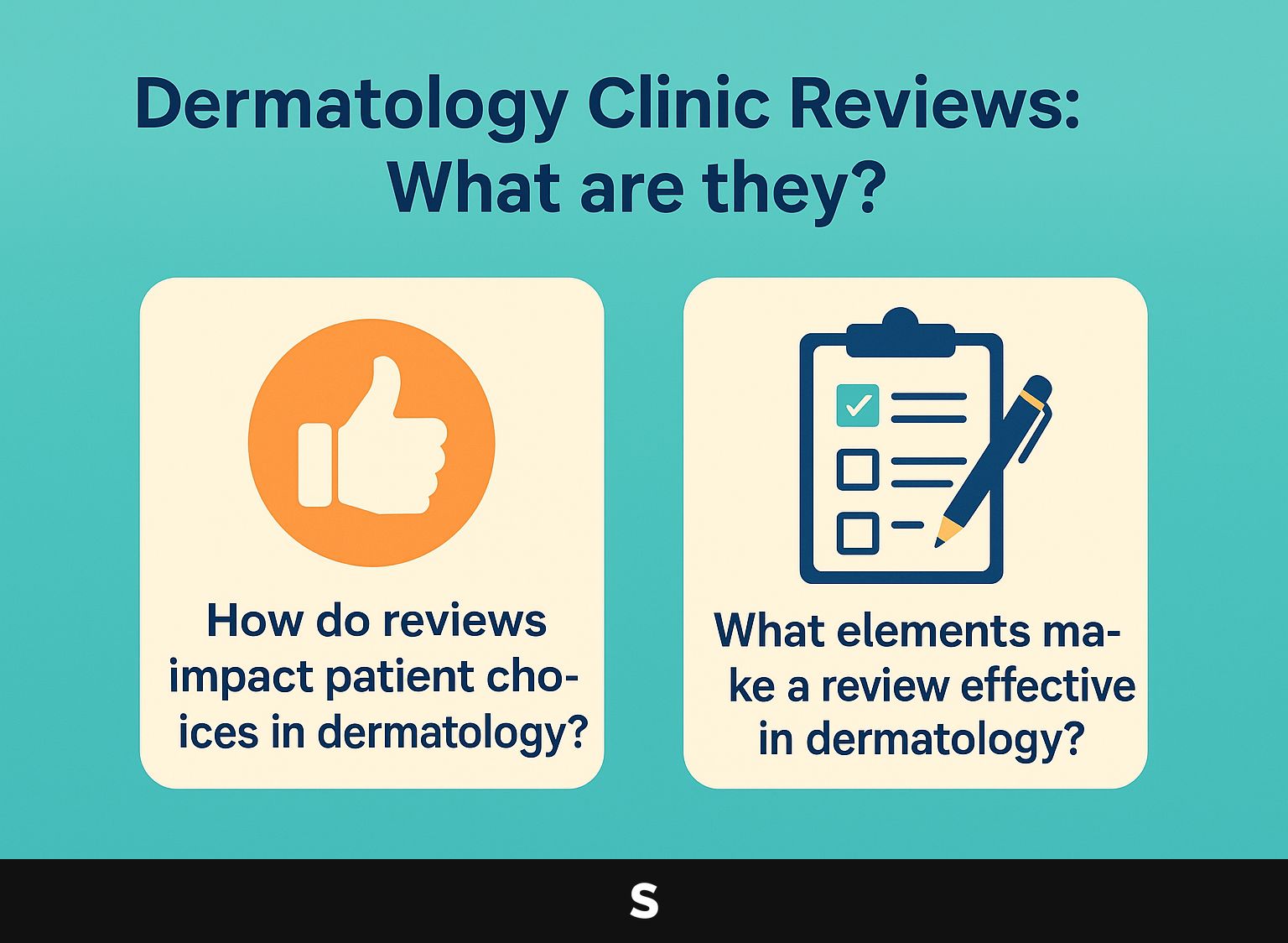
1. How do reviews impact patient choices in dermatology?
Research indicates that 70% of patients consider online reviews to be influential when selecting a dermatologist, reflecting the importance of perceived provider quality.
Studies show that 58% of patients are more likely to book an appointment with a provider who has an average rating of 4 stars or higher. Dermatologists should ask happy patients to write reviews on sites like Google My Business and Yelp to make the most of their feedback.
Using tools like Reputation.com can simplify this process by sending automatic requests for reviews after appointments. Regularly replying to reviews, whether good or bad, can build patient trust and affect the choices of potential patients.
2. What elements make a review effective in dermatology?
Good dermatology reviews often mention clear treatment results, feelings about the experience, and how professional the staff was, which connect with other patients.
To write an engaging review, start by explaining your treatment process. For instance, if you received laser therapy, explain the procedure and results you achieved.
Share genuine emotions during your visit-perhaps the comforting nature of the staff eased your anxiety. Mention specific staff members and their actions, using their names when possible, to make your experience more personal.
Try to include timelines, such as how long you waited for the treatment results, helping readers gauge expectations. Consider also mentioning any follow-up care, which demonstrates the clinic’s commitment to patient well-being.
Patient Experiences and Their Importance
Patient experiences in dermatology greatly influence how people view treatment success, as they often share their personal stories of dealing with skin conditions.
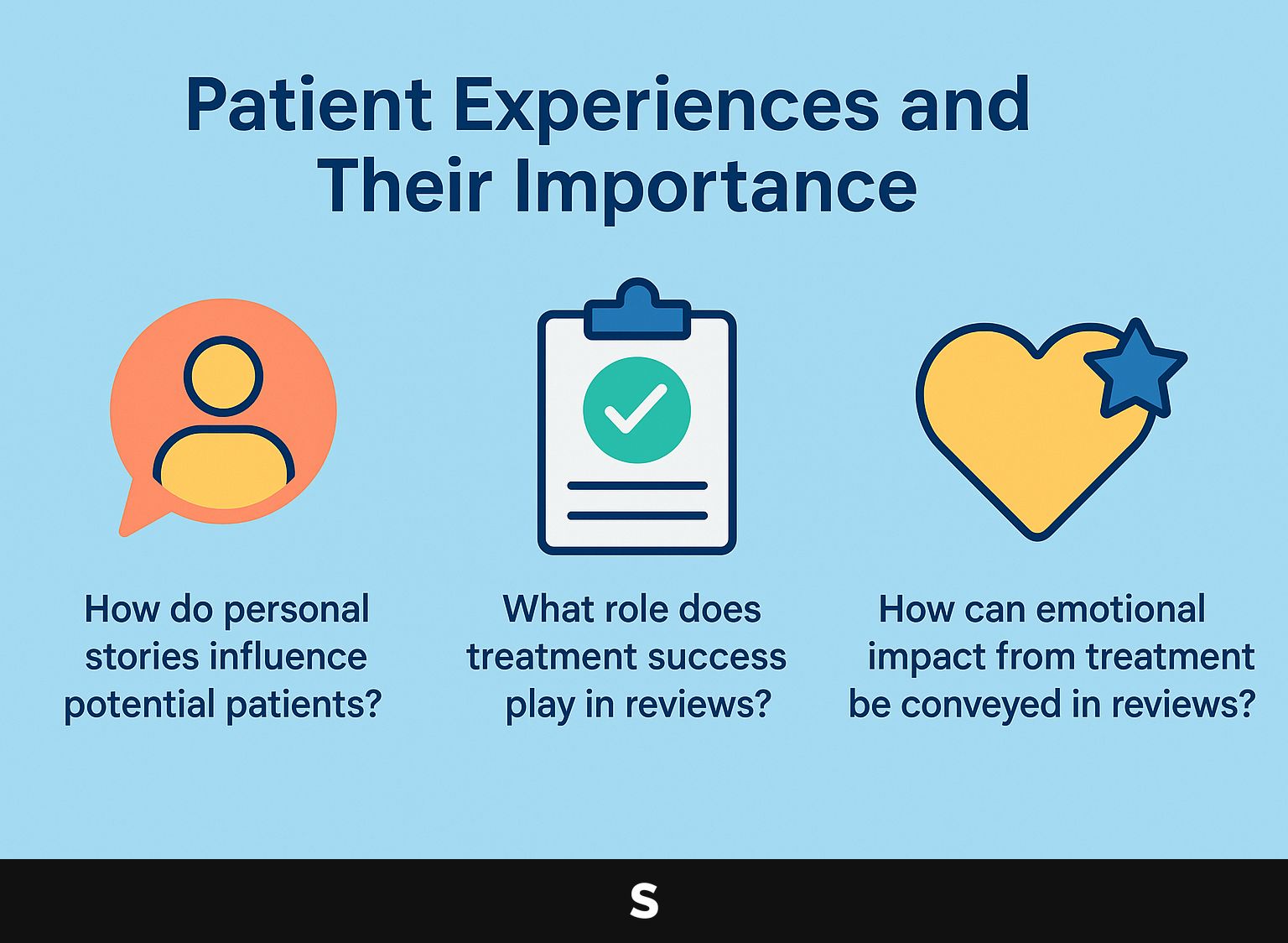
1. How do personal stories influence potential patients?
Personal stories about life-changing skin treatments often connect with potential patients and encourage them to try similar treatments.
For example, testimonials that show major changes, like a patient describing their experience from having bad acne to clear skin after a certain treatment, can create empathy and make others feel connected.
Platforms like RealSelf allow patients to post before-and-after photos alongside their narratives, engaging others. Presenting statistics-like `90% of users saw improved skin clarity after three months’-adds credibility.
These real stories show how well the treatments work and create an emotional bond, encouraging readers to imagine their own potential changes.
2. What role does treatment success play in reviews?
Reports of treatment success, like noticeable skin improvement in a few weeks, can greatly improve a clinic’s reputation and help draw in new patients.
Clinics should actively encourage satisfied patients to share their experiences online. Sending follow-up emails after appointments can encourage patients to leave reviews, asking them about the specific results of their treatments.
Showcasing before-and-after photos on social media and review platforms can provide tangible proof of success, which often translates into increased inquiries. Studies show that clinics with over 50 positive reviews typically see a 30% rise in new patient appointments, indicating a strong correlation between review positivity and patient interest.
3. How can emotional impact from treatment be conveyed in reviews?
Reviews that describe the emotional effects of treatment-like feeling more confident and having better mental health-help potential patients see the full benefits of dermatological care.
To effectively communicate these experiences, clinics should gather detailed testimonials. Encourage patients to discuss their physical improvements and how these changes impact their daily routines.
For example, a patient might express how clearer skin helped them engage socially with newfound confidence. Another could share how their condition’s management led to less anxiety in professional settings.
Use platforms like Google Reviews or social media to show real opinions. This real-life example will connect with potential patients on a personal level, showing how treatment advantages relate to them.
Key Components of Impactful Dermatology Reviews
Effective dermatology reviews include important parts that increase trust and usefulness for new patients, such as specifics about treatments and how the staff interacts with patients.
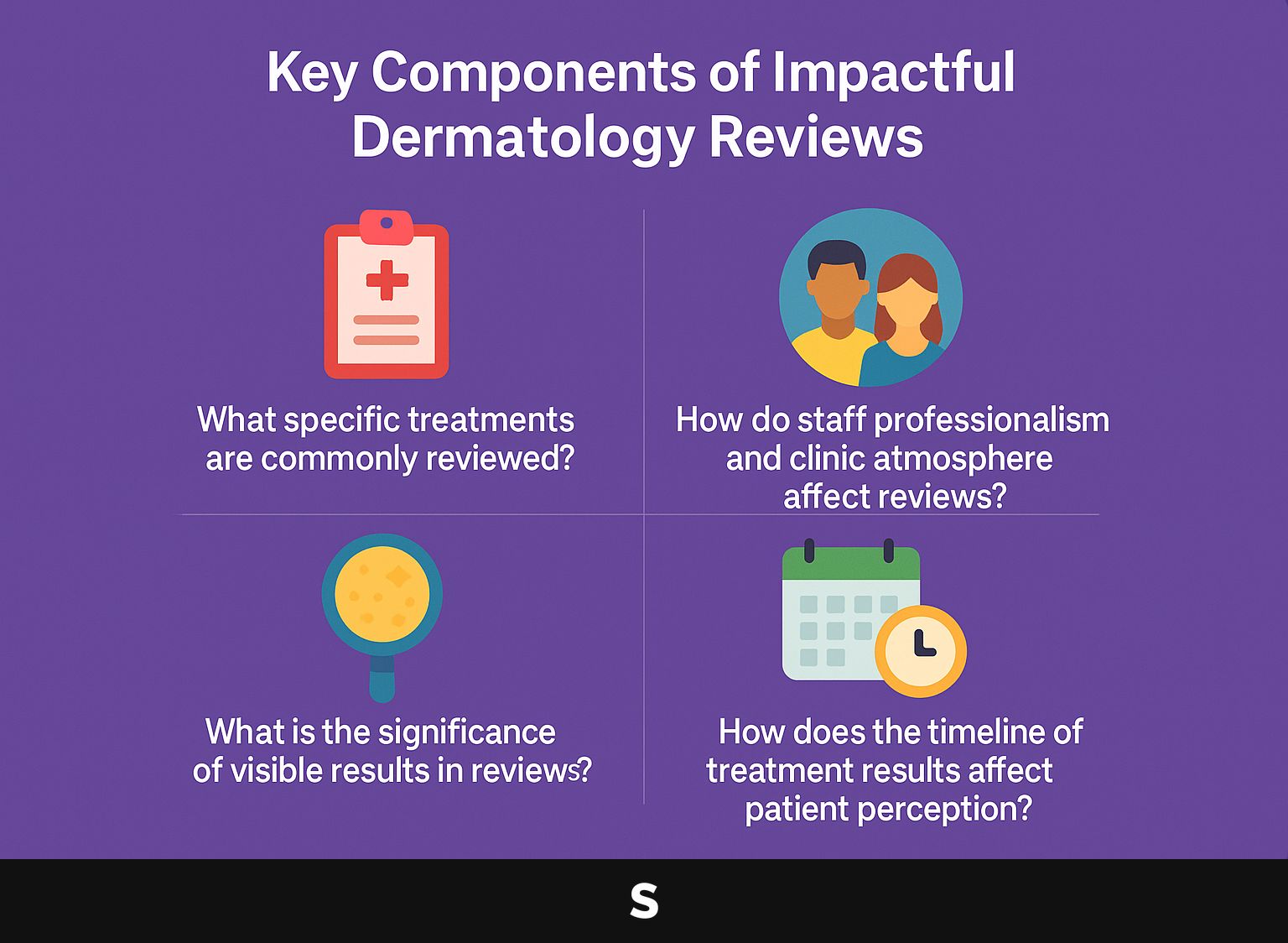
1. What specific treatments are commonly reviewed?
Commonly reviewed treatments in dermatology include acne therapies, Mohs surgery for skin cancer, and cosmetic procedures like CoolSculpting, each attracting considerable patient feedback.
Among acne therapies, treatments like topical retinoids (such as Tretinoin) receive positive reviews for their effectiveness in preventing new breakouts.
Patients often express satisfaction with Mohs surgery because it precisely targets cancerous tissue and has a low likelihood of the cancer coming back.
Meanwhile, CoolSculpting, generally praised for its non-invasive nature, typically shows encouraging results in fat reduction.
Trends indicate that patients favor treatments that combine efficacy, safety, and minimal downtime, leading to a significant number of positive reviews and recommendations.
2. How do staff professionalism and clinic atmosphere affect reviews?
The professionalism of staff and the overall atmosphere of a dermatology clinic can significantly sway patient reviews, often correlating with higher satisfaction rates.
To improve these areas, clinics can begin by putting money into staff training programs that concentrate on communication skills and empathy. For instance, role-playing exercises can prepare staff for various patient interactions.
Next, improving the clinic environment is important; think about adding calming features like soft lighting, soothing colors, or playing gentle music in waiting areas.
Getting patient feedback through surveys shows where changes are needed, which helps improve patient experiences and gather more feedback.
3. What is the significance of visible results in reviews?
Visible results from treatments, such as clear skin after an acne regimen, are often the focal point of positive reviews, demonstrating effective care and leading to higher patient trust.
To make treatment results clearer, clinics should ask patients to include before-and-after photos with their reviews. This can be done by giving rewards, like discounts on upcoming services or a chance to win a prize in a raffle.
Clinics can create a dedicated section on their website or social media pages for these testimonials. By encouraging the use of a hashtag linked to their treatments, they can gather content in one place, letting potential clients view real results while building a community feeling among patients.
4. How does the timeline of treatment results affect patient perception?
The timeline in which patients see results can greatly influence their perception of care quality, with quicker results often leading to more favorable reviews.
Clinics should set clear, realistic timelines based on treatment types. For example, physical therapy might show improvements within 4-6 weeks, while skin treatments could take 3-6 months for full results.
Communicate these expectations during initial consultations, providing brochures or digital resources outlining typical outcomes. Implement follow-up surveys after key milestones to solicit feedback, enhancing patient engagement and showcasing your commitment to their progress.
This forward-thinking method builds trust and helps change plans based on what patients go through.
How can clinics encourage patients to leave positive reviews?
Encourage patients to leave good reviews by personally asking them and reminding them during follow-up visits. This can help make the clinic more visible online.
Consider implementing a structured follow-up process that includes sending thank-you emails post-visit, along with links to your review platforms. Tools like PatientPop or Birdeye can help make this outreach process automatic.
Provide minor rewards for feedback, like discounts on next visits or a chance to win in a monthly draw. For instance, clinics that have shared success stories report a 30% increase in positive feedback, demonstrating the effectiveness of these strategies in building a strong online reputation.
Building Patient Confidence Through Reviews
Positive feedback can greatly increase patient confidence, making them feel more certain about choosing a clinic and the treatment they will receive. As mentioned, this can be achieved by effectively utilizing positive review examples to showcase the clinic’s strengths and previous patient satisfaction.
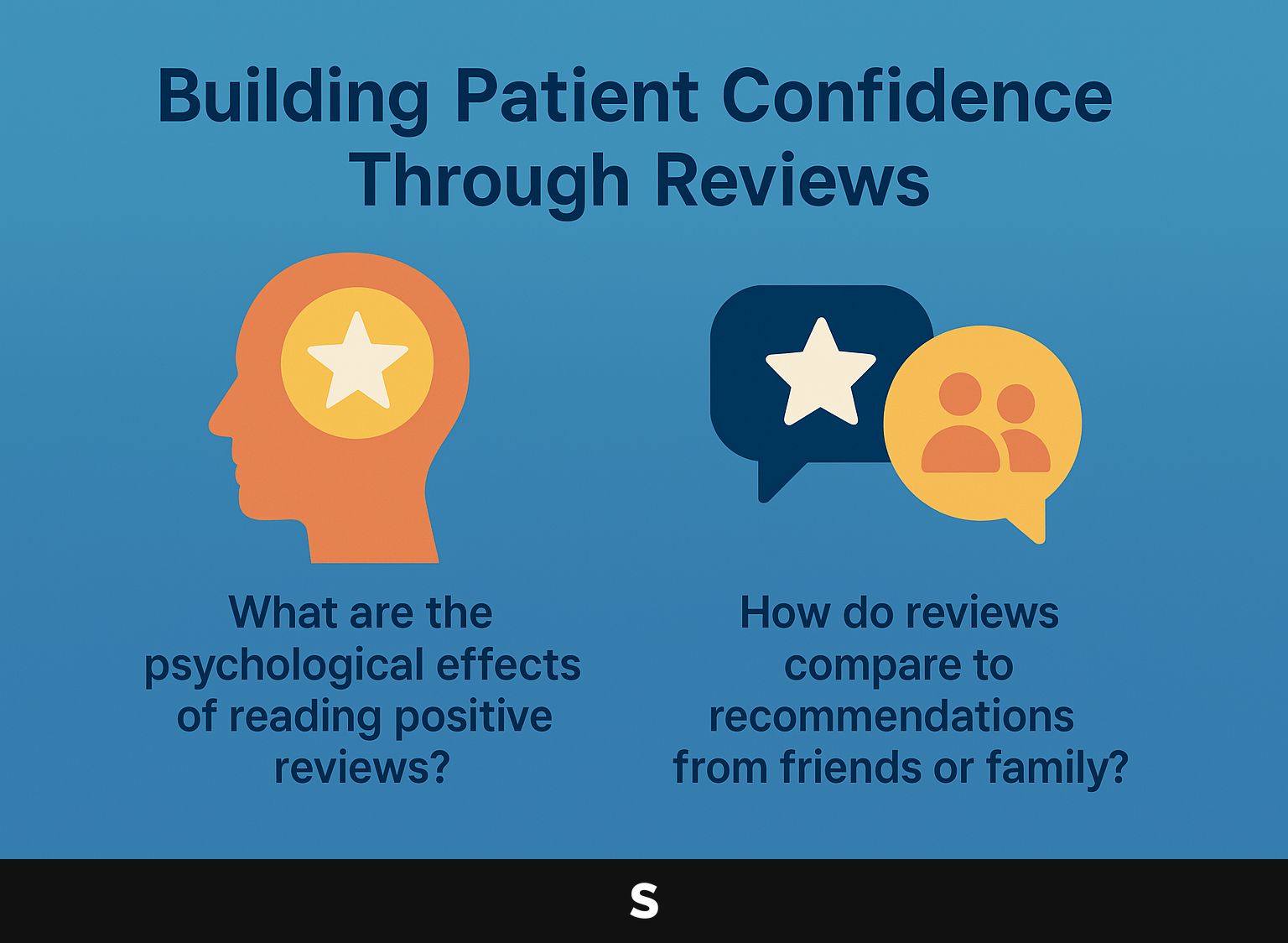
1. What are the psychological effects of reading positive reviews?
Reading positive reviews can evoke feelings of hope and trust in prospective patients, often leading to increased likelihood of visiting a clinic.
This emotional response is backed by studies showing that patients who read favorable testimonials are significantly more likely to inquire about treatments.
For instance, a research study published in the Journal of Medical Internet Research found that clinics with higher review scores saw a 30% rise in appointment requests. Adding reviews in marketing content can strengthen this effect; showing high ratings with quotes from happy patients can improve perceived credibility.
Clinics can improve feedback by requesting reviews from patients through follow-up emails or prompts during their visit, resulting in more positive feedback.
2. How do reviews compare to recommendations from friends or family?
While personal recommendations are important, online reviews give a wider view and are often trusted by patients as reliable information.
In fact, a recent survey found that 85% of patients trust online reviews as much as personal recommendations. People trust this because there is a lot of feedback available, providing clear information about healthcare providers.
To make the most of both sources, patients should start by asking for suggestions from friends and family, and then look at online reviews on sites like Healthgrades or Yelp. This dual approach enables patients to make well-informed decisions, aligning personal experiences with collective evaluations.
Addressing Common Concerns in Dermatology Reviews
Patients who are worried about skin treatments can feel more at ease by reading clear and detailed reviews.
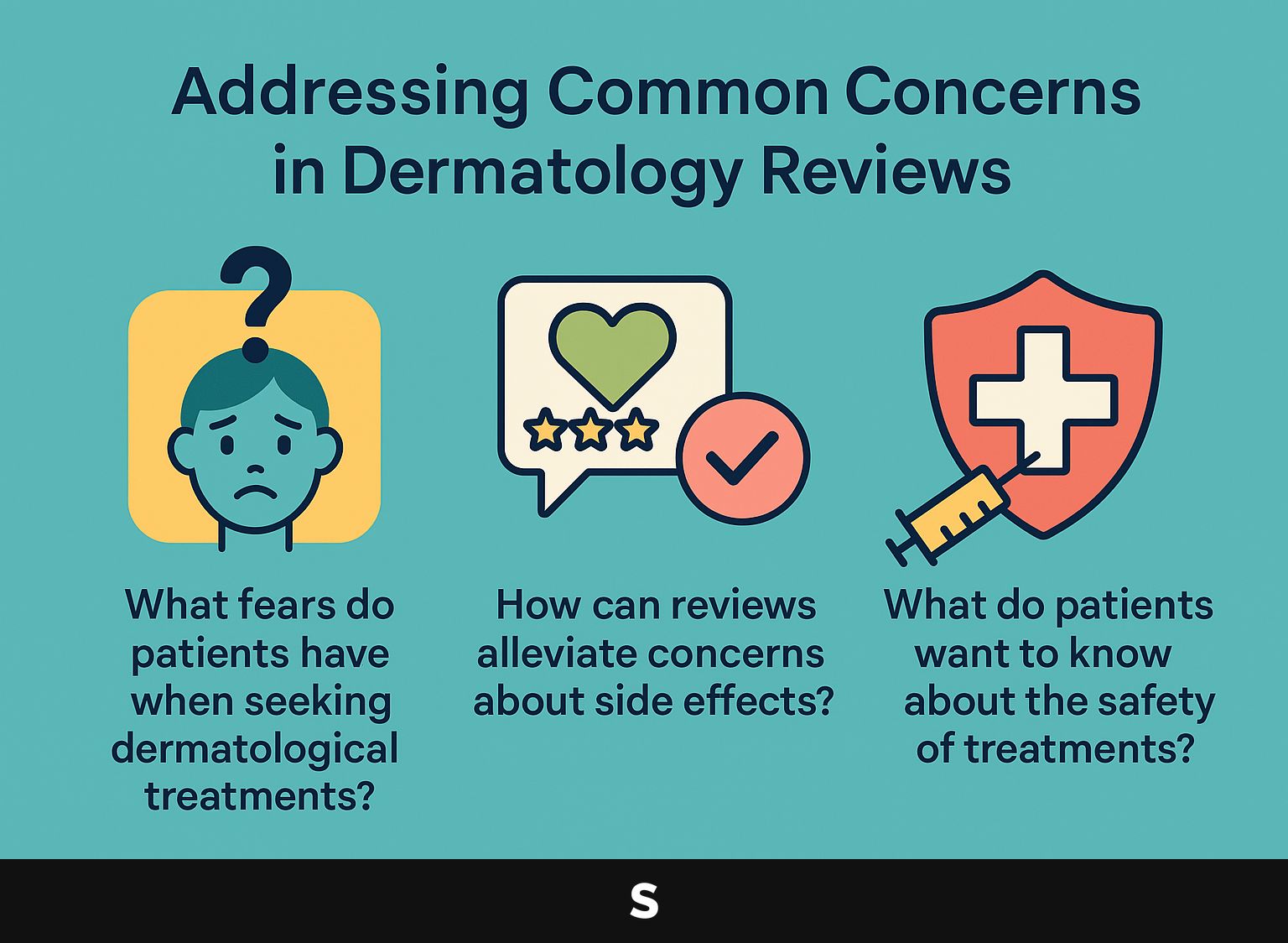
1. What worries do patients have when looking for skin treatments?
Patients often worry about side effects and whether treatments will work, which can stop them from getting needed skin care. To clearly explain safety and how well treatments work, clinics should use different methods.
Clear patient education materials that explain possible side effects and provide statistical success rates can help clarify treatments. Using testimonials from previous patients can create a sense of community and trust.
Clinics can also host Q&A sessions-either in-person or through webinars-allowing patients to voice concerns directly. Implementing these strategies can significantly alleviate fears and encourage patients to pursue the care they need.
2. How can reviews alleviate concerns about side effects?
Reviews that openly talk about side effects and how they were handled can greatly reduce patient worries and build trust in getting treatment.
To effectively frame discussions around side effects, clinics should encourage reviewers to share both negative and positive experiences.
For instance, if a patient felt sick to their stomach, ask them to explain how they managed it, like having food before taking medicine or sipping ginger tea. Giving patients a place to talk about how they manage challenges builds a caring community.
Consider using case studies in promotional materials that highlight resolved side effects, emphasizing the overall benefits of treatment. This approach reassures possible patients and increases confidence in the clinic’s care methods.
3. What do patients want to know about the safety of treatments?
People often want detailed information about the safety of skin treatments before deciding. They usually look at reviews to feel comfortable.
Clinics can take steps to answer patients’ safety questions by including detailed FAQs in their information packets. Highlighting specific safety protocols, such as the use of FDA-approved products and trained staff, builds trust.
Sharing real patient stories about positive experiences with safety can build trust. Including visual content, such as before-and-after photos along with testimonials, also adds a layer of transparency.
Keeping these materials updated with the latest safety practices or research findings means patients have the newest information, helping them feel secure about their treatment choices.
Online Activity: The Importance of Being Visible Online
It’s important for dermatology clinics to have a solid online profile because it affects how much patients trust and interact with them through reviews and feedback.
1. How does a clinic’s online reputation affect patient trust?
A clinic’s online reputation, supported by positive reviews, is important for earning trust with potential patients and affects their choice to get care.
To keep track of and improve their reputation, clinics can use tools like Google Alerts to get immediate notifications about reviews or mentions. Engaging on platforms such as Yelp or Healthgrades encourages satisfied patients to leave positive feedback.
Replying to all reviews-whether positive or negative-shows dedication to keeping patients happy, building trust. Regularly assessing social media engagement can also identify areas for improvement, allowing clinics to effectively address concerns and showcase their strengths.
2. What platforms are most effective for dermatology reviews?
Websites such as Google Reviews, Yelp, and Healthgrades play a key role in forming the public’s view of dermatology clinics based on patient reviews.
For better visibility on these platforms, clinics should ask happy patients to write reviews. Make it simple by sending follow-up emails or providing QR codes.
Checking these reviews often will help clinics respond to any negative comments quickly, showing they care about patient feedback. Replying to both good and bad reviews in a professional manner can greatly improve your reputation.
Using tools like ReviewTrackers or BirdEye can simplify the process of managing many review sites, allowing clinics to keep track of feedback and find out patients’ opinions.
Leveraging Reviews for Clinic Growth
Using reviews well can help dermatology clinics grow, improve their services, and make patients happier. For clinics aiming to boost their online presence, exploring how to get Google reviews specifically for dermatology clinics is a hidden gem worth considering.
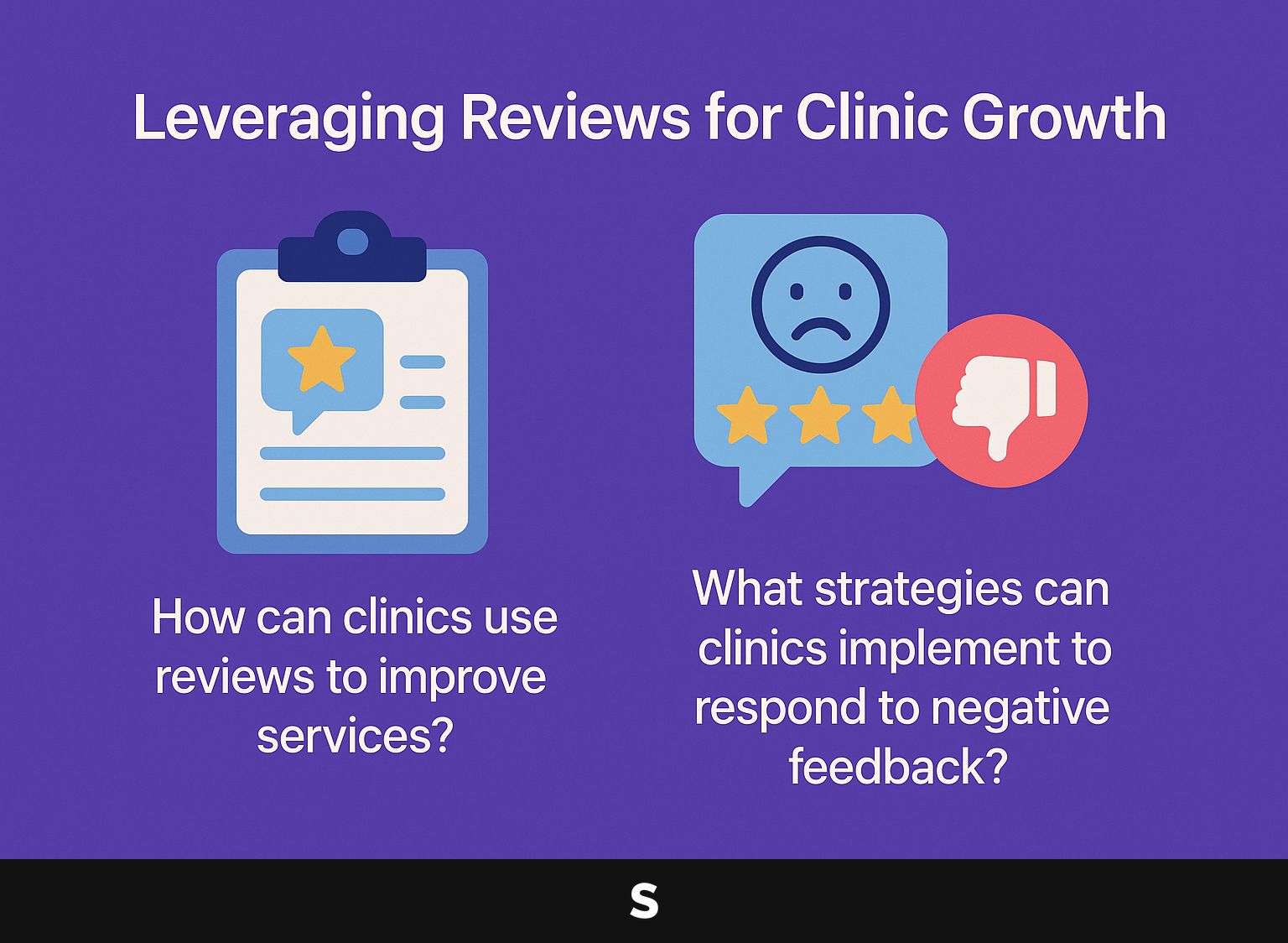
1. How can clinics use reviews to improve services?
By regularly analyzing patient feedback, clinics can find areas needing improvement and use this information to provide better services.
To implement this process effectively, clinics should start by utilizing tools like PatientBond to gather feedback, followed by analyzing data with Graphite Health.
For actionable changes, prioritize common themes from reviews-such as staff communication or wait times. For instance, a dental clinic improved patient satisfaction by 30% after streamlining appointment scheduling based on feedback.
Share improvements with patients through newsletters, creating a transparent culture that encourages ongoing feedback and trust in the clinic’s commitment to quality service.
2. What strategies can clinics implement to respond to negative feedback?
Addressing negative feedback in a timely manner can reduce harm and show a clinic’s dedication to caring for patients and improving quality.
Start by acknowledging the patient’s concerns with empathy, such as saying, “We appreciate your feedback and are sorry to hear about your experience.”
Next, provide a short explanation or solution by saying, “We are checking our procedures to prevent this issue from happening again.”
Invite further communicationPlease contact us directly at [phone number] so we can discuss this further.” This method can fix the issue and show upcoming patients that the clinic cares about their opinions.
Future Trends in Dermatology Reviews
As technology progresses, the way dermatology reviews are done is expected to shift, using more online interactions and new platforms for patients to share their opinions.
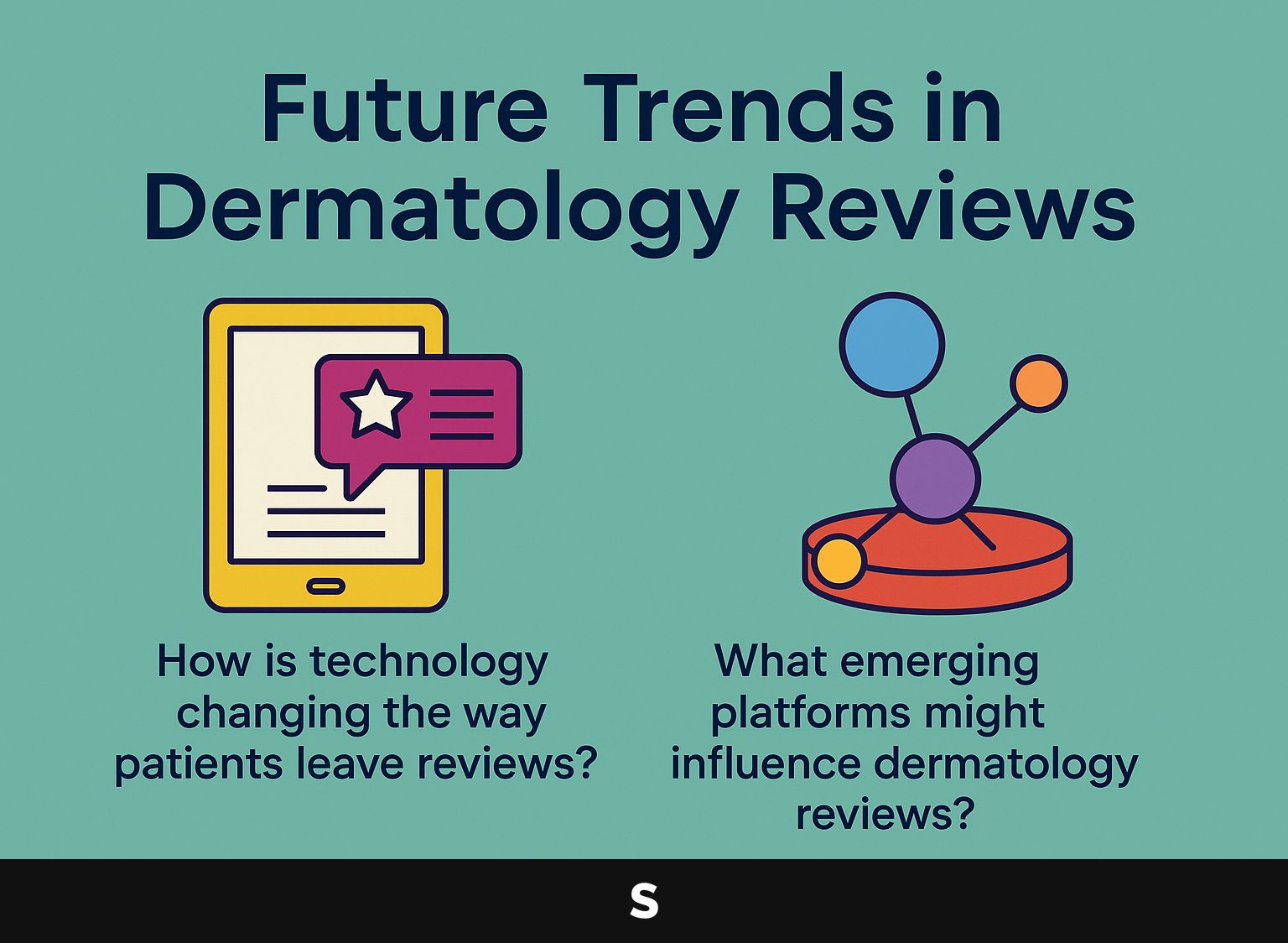
1. How is technology changing the way patients leave reviews?
Technology improvements, like mobile apps and patient portals such as MyChart, are simplifying the review process, allowing patients to easily share their experiences. These tools allow for real-time feedback through surveys and ratings, enhancing patient engagement.
Patients can quickly and easily complete surveys on their phones after their appointments. Clinics can use platforms like PatientPop or CareDash to gather and display reviews, promoting openness.
These technologies help patients get feedback easily and make them feel more involved in their care. This encourages open communication in healthcare settings.
2. What emerging platforms might influence dermatology reviews?
Platforms such as social media and specialized healthcare review sites are gaining traction, influencing how patients view dermatology services and share experiences.
Clinics should use a variety of methods to effectively connect with patients on these platforms.
- First, establish a strong presence on popular social media channels such as Instagram and Facebook, where visuals of treatments and before-and-after photos can capture attention.
- Next, keep an eye on review sites like Healthgrades or Zocdoc. Reply to both good and bad feedback to build a clear and open image.
- Consider creating educational video content that addresses common skincare questions, which can be shared across platforms to build trust and position your clinic as a knowledgeable authority in dermatology.
Frequently Asked Questions
1. What are Dermatology Clinic Reviews That Build Patient Confidence?
Dermatology clinic reviews that build patient confidence are reviews or testimonials written by patients who have had positive experiences at a dermatology clinic. These reviews highlight the successful treatment results, the professionalism of the staff, and the overall impact on the patient’s confidence.
2. How can Dermatology Clinic Reviews Build Patient Confidence?
Dermatology clinic reviews can build patient confidence by showcasing real-life success stories and testimonials from previous patients. These reviews can make new patients feel at ease and sure about the clinic’s services and skills.
3. Why are Dermatology Clinic Reviews Important?
Reviews of dermatology clinics are important because they give useful information about the quality of services and the satisfaction of past patients. These reviews also help potential patients make informed decisions when choosing a dermatology clinic.
4. Can Dermatology Clinic Reviews Be Trusted?
Yes, dermatology clinic reviews can be trusted as they are written by real patients who have had first-hand experiences with the clinic. These reviews are often unbiased and provide honest feedback about the clinic’s services and results.
5. How Do Dermatology Clinic Reviews Benefit Patients?
Reviews of dermatology clinics help patients learn about the clinic’s services and what results to anticipate. These reviews make patients feel more sure and comfortable when looking for treatment.
6. Where Can I Find Dermatology Clinic Reviews That Build Patient Confidence?
You can find dermatology clinic reviews that build patient confidence on various platforms such as the clinic’s website, social media pages, and review websites like Yelp or Google Reviews. You can also ask for recommendations from friends or family who have had positive experiences at a dermatology clinic.
